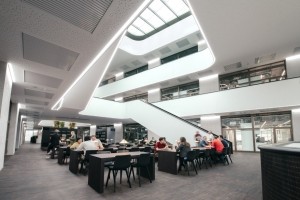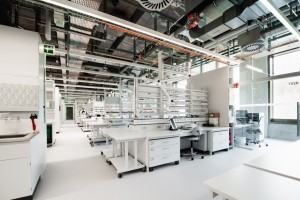Givaudan opens flagship innovation centre in drive for ‘speed efficiency and new solutions’
Flavours and fragrances supplier Givaudan officially opened its CHF120 million ‘flagship’ innovation centre in Kemptthal, Switzerland, on Friday (14 June).
“Our flagship Zurich innovation centre will accelerate global efforts to create differentiated and sustainable flavour, taste, and fragrance solutions for the food and beverage and consumer packaged goods industries,” flavours chief D’Amico explained. “It’s a place where Givaudan is innovating and developing state of the art technology with a strong focus on naturals, health and wellbeing, and sustainability.”
While Givaudan operates a number of innovation sites across the globe – from Shanghai to the USA and Europe – the new facility nevertheless represents something of a “step-change” for the company in terms of the scale of investment and from a sustainability standpoint – “the things that we are working on and tackling there" – D’Amico told FoodNavigator.
Sustainability by design
The centre embodies the approach Givaudan takes to sustainability – building it into the design of both processes and products.
“Sustainability is a very big topic, there is a very big need. We are applying this across Givaudan. It is in every area of our business. We take a sustainability approach to everything we do. Through our sustainability framework, which we call‘A Sense of Tomorrow’, we consolidate efforts in three key areas: sourcing, innovation and the environment,” D’Amico explained.
The centre itself has been designed to minimise the environmental impact of operations. The building has been awarded a gold certificate from Leadership in Energy and Environmental Design (LEED), the world's most widely recognised green building certification system. The workplace design reduces water and energy consumption and improves environmental and economic efficiency by up to 45%, according to the company.
On responsible sourcing, D’Amico said Givaudan believes in working closely with its supply chain to develop shared values that benefit the company, producers and communities. “It is a very holistic approach.”
For Givaudan, sustainable innovation is about the how and where of the innovation process. For example, Givaudan’s innovation efforts are focused on delivering natural solutions in areas like plant-based protein.
“In you think of innovation, plant-based protein is a great example, taking the focus away from [meat which is] is required in the environment.”
The Swiss ingredients giant is also eyeing areas like vertical farming, which is “helping to reduce the footprint” of the plants the company utilises. D’Amico explained that this is still a “new” area that the company is exploring as part of its science and technology function – but he is particularly optimistic about “cell culture technology” in this area, designing products to deliver a desired impact.
Open innovation: more than a ‘buzzword’
The 12,000 square metre innovation facility, part of Givaudan’s global innovation ecosystem, consists of 24 laboratories and provides a workspace for 300 employees as well as an open innovation space to facilitate “close collaboration and cooperation” with the ingredient manufacturer’s suppliers, customers, partners and start-ups.
D’Amico said that this approach to open innovation is more than the latest industry watchword for Givaudan. “It is a buzzword and I don’t like buzzwords because everything gets painted with a broad brush. When we talk about open innovation, we are talking about collaboration and co-creation with our partners, universities, suppliers as well as our customers. Where we engage with consumers, it is to learn and understand what they need.
“Essentially, it is working together in the pilot facility, the Givaudan innovation centres, and opening up. You have to be willing to share the information, so you can create something that is bigger and better by using the combined information and expertise.”
Working with external partners, and start-ups in particular, has required Givaudan to adapt its processes. Start-ups and corporates often report speaking a different language and functioning on wafer-thin margins start-up innovators operate at a speed rarely seen in the corporate world.
“We have had to change. In order for us to interact and be relevant for start-ups we have had to speed up, we have to get the bureaucracy out, we have to show agility. That is open innovation. Getting us on that path of speed, quick decision making outside of the corporate umbrellas and heavy processes that are typically in place.”
Accelerating innovation
Across the food sector, the speed of innovation is increasing as finished goods manufacturers work to shorten their product pipelines.
Givaudan’s long-term investments in innovation mean that it has developed a number of “smart tools” that address this need. These tools, from the groups mini-virtual aroma synthesiser (VAS) to Flavour Vision tech and Flavour Kiosks, combine a proprietary algorithm developed by Givaudan’s science and technology group with artificial intelligence.
“We can work with customers, consumers or start-ups to rapidly develop and do rapid prototyping using another tool called SPRINT,” D’Amico explained. “This allows us to make the new product development time, from ideation to validation, much faster. Taking it from what used to be months to literally days in the week.”
Givaudan started this journey 12 years ago when the company started building the data it would require around each raw material. It has now digitalised its database and is using algorithms for proprietary partition coefficients and “things of that nature”.
“It is a great technology to get the sensory profiles consumers are looking for and help our customers zero in quickly.”
Addressing industry challenges
Accelerating innovation is necessary to address the challenges the food industry now faces, D’Amico suggested.
These include changing consumer attitudes towards “ingredients, the origin of ingredients, how things are labelled on the package, the authenticity, interest in sustainability, and health and wellness”.
Natural products that deliver a clean label have been a “huge trend” and this has presented both a challenge and an opportunity for the flavours industry.
“In the context of clean label, flavour delivery systems are really important. Flavours often require a carrier to encapsulate for applications that are in dry form. Things like tea or soup or even meal seasonings. We are using nature to solve the challenge. For example, we are taking seeds things like sesame seeds, and using that as a carrier to encapsulate natural flavours. We recently patented the tech,” he revealed.
Looking at health and wellbeing, D’Amico sees a number of Givaudan’s innovation priorities coalescing. “There are a couple of areas we put under that: Naturals being one. If you think about the whole naturals portfolio, we have done a lot with acquisitions to expand the portfolio,” he said referring to the company’s most recent acquisition of natural flavours supplier Naturex.
“Plant based proteins is another great example. And the third, which has been more traditional and continues over the last several years has been around sugar reduction sodium reduction to deal with the health related issues.”
On sugar reduction, what Givaudan terms the ‘war on sugar’, the company has taken an approach that sees it develop flavours that it says are “fully satisfying” without the use of sweeteners.
“We push the limit on sugar reduction… When we talk about the war on sugar, we know consumer interest in less sweet products is driven by health concerns as well as the desire for a lighter taste. We call it our ‘beyond sweetness’ programme, we have used natural sugar reduction that is fully satisfying but does not rely on the presence of sweeteners. We have taken a holistic approach to make the product taste great on its own without the addition of sugar or sweeteners.”
This shift is evident in both developed and developing markets – and D’Amico expects innovation in these areas to continue apace.
“These new trends demand speed efficiency and new solutions. That is where innovation comes in.”




























